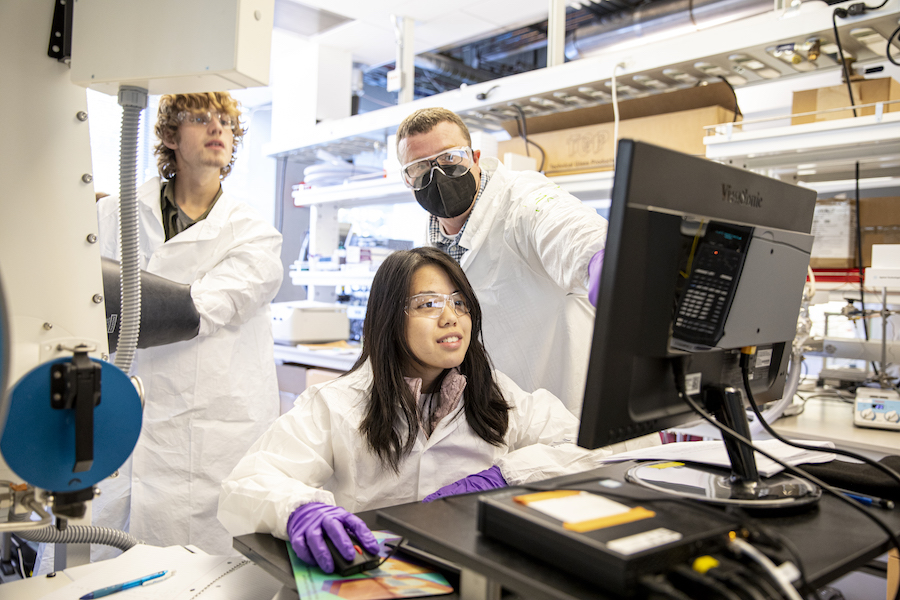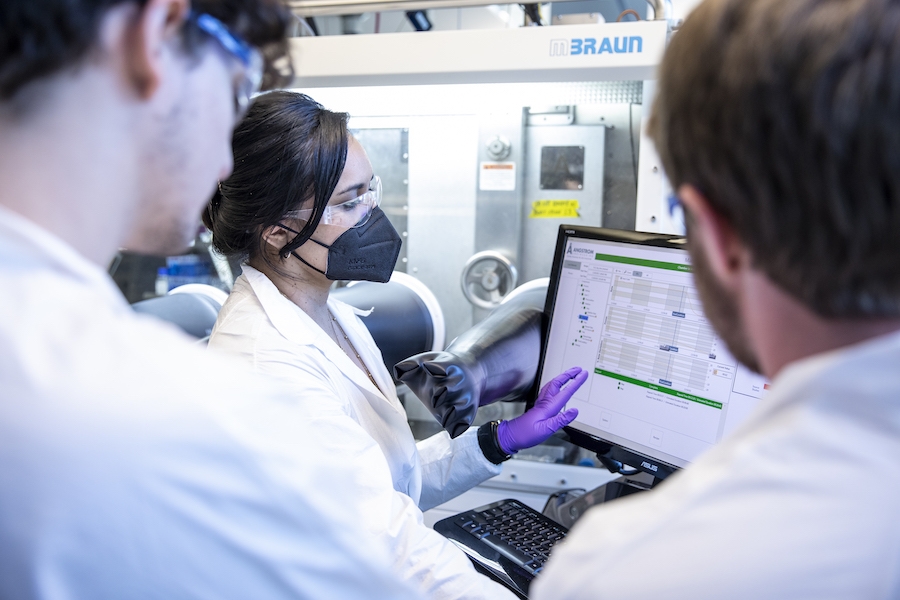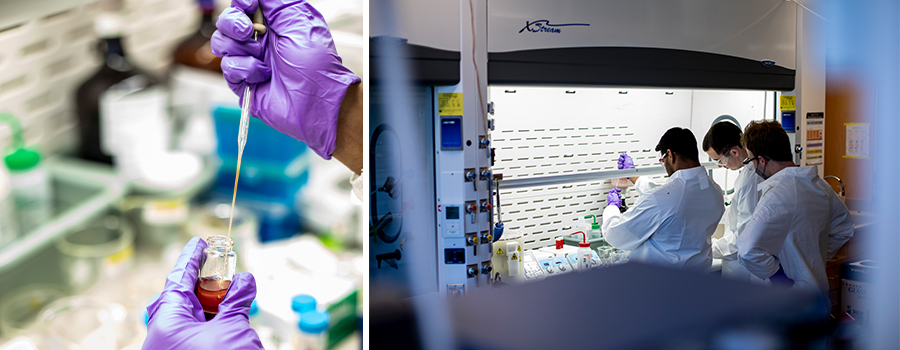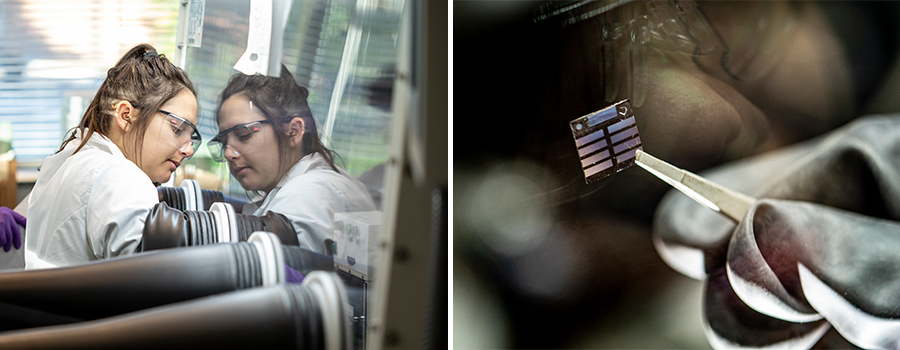
A multi-disciplinary course is training students across the scales of clean energy — from materials and devices to storage and power grid integration.
December 12, 2022
By Chelsea Yates | Photos by Dennis Wise / University of Washington
“I’ve grown up witnessing climate change first-hand — more severe wildfires, draught, hurricanes, and the list keeps growing unfortunately,” says materials science and engineering (MSE) graduate student Arun Sundar. “We need to understand the broader effects of climate change, and we need to take action.”
For him, this has meant a course of study in energy storage and emerging energy technologies. Sundar decided to attend the UW because of its MSE program’s leadership in energy storage research and collaborations with national laboratories and because of the Clean Energy Institute (CEI).
“The idea of an initiative with faculty from a range of specialties — all with a common goal of researching and innovating clean energy technologies — is a model for how I view a more successful future,” he says.
This fall, Sundar was one of thirty students enrolled in “Energy, Materials, Devices and Systems” (EMDS), a course created by the CEI. Housed in its Research Training Testbed (RTT), it gives students a hands-on, holistic understanding of clean energy development and implementation.
Offered every autumn since 2015, EMDS trains upper-level undergraduates and graduate students across the scales of clean energy — from working with materials at the nano-scale for energy generation and storage to planning for large-scale integration into energy systems.
“The course reflects the CEI’s mission in many ways, but especially in its cross-disciplinary approach to research, skills development and application at scale,” says class instructor and Washington Research Foundation Innovation Associate Professor of Chemistry and Clean Energy Cody Schlenker.
This approach is precisely what appealed to Sundar. Though familiar with some of the processes and devices covered in class, like coin cell batteries, other concepts — such as understanding how quantum dots work and studying particles at the nanoscale — were completely new to him.&
“I likely wouldn’t have been exposed to topics like these through my regular coursework,” he says.
‘Collaboration is critical’
Accelerating the adoption of scalable and equitable clean energy is no simple task, and while there’s a lot of potential in clean energy, there are also a lot of challenges.
“The scope is so broad and the scale is so big it will take all of us working together to come up with solutions that are affordable, efficient, scalable and accessible,” Schlenker says. “That’s one reason why it’s important to educate students across disciplinary boundaries.”
In addition to training students in different disciplinary perspectives, EMDS is open to students from different academic backgrounds. Most who enroll tend to come from engineering, chemistry and physics, but even business students have taken the class.
“Advancing solar energy and batteries, and their integration with systems and the grid, isn’t something that’s going to be figured out in one lab, or even one discipline,” adds EMDS teaching assistant (TA) and mechanical engineering graduate student Malia Steward. “It’s going to take materials scientists, chemists, mechanical and electrical engineers, businesses, community leaders and so many more. Collaboration is critical.”

Initiated by CEI’s chief scientist and Alvin L. and Verla R. Kwiram Endowed Professor of Chemistry David Ginger, who brought together CEI member faculty from several departments to design the curriculum, EMDS is structured around weekly modules. Each focuses on a different area of clean energy and is facilitated by a TA who specializes in that area. For example, Steward’s Ph.D. research centers on light trapping structures for solar photovoltaic cells, and for the class she facilitates a module on fabricating organic photovoltaics and characterizing their performance.
“This class has given me a wider view of renewable energy, and I’ve been researching in this area since I was an undergraduate,” she says.

Unique structure, assignments and environment
Students move through the weekly modules in small groups. They start with nanoparticle synthesis and solar photochemistry characterization. By weeks four and five, they’re building batteries and focusing on solar cells and energy storage. Then they move on to 2D materials characterization. By the end of the quarter, they’re simulating power grid responses, all the while learning how research can be translated from lab to market.
The structure is one of Cassidy Sarah Anderson’s favorite things about the class. “We’re grouped with one or two other students from different academic departments, and each week our small group is supervised by a TA who is actively researching in the area they’re teaching,” the MSE graduate student explains. “The experiments we’re doing align with what’s happening in research right now, which makes the class fresh and relevant.”
We want students to come away with an appreciation for creativity, sharing knowledge and gaining a new perspective about their role in the clean energy transformation.” — EMDS teaching assistant Malia Steward
Students submit detailed lab reports after each module, and Anderson and Sundar say that writing these reports has been invaluable.
“I’ve developed technical writing skills and literature survey skills that I will use in grad school and in my career,” says Anderson, who also works as a materials scientist at the Pacific Northwest National Laboratory (PNNL).
“Learning how to convey dense scientific ideas concisely isn’t a skill that’s taught in most engineering classrooms. As a scientist or engineer, it’s difficult to make a meaningful impact if you can’t communicate your ideas clearly,” Sundar says. “The EMDS reports put the pressure on us students to explain how the labs are relevant to real-world problems.”
EMDS meets in the RTT, a prototype facility and technology incubator on campus. Part of the Washington Clean Energy Testbeds system, the RTT provides students access to industrial-quality research tools.
“The RTT’s synthesis and testing equipment is state-of-the-art and almost the exact same equipment as what I use in my day job,” says Anderson. “Having that sort of alignment and continuity — across academia, national laboratories and industry — is excellent for professional training and development. It really prepares students for their next steps.”

According to Steward, that’s one of the goals of the course.
“We want students to come away with an appreciation for creativity, sharing knowledge and gaining a new perspective about their role in the clean energy transformation,” she says.
And, Schlenker adds, a renewed sense of urgency.
“Every year that I teach this course, I am reminded of the positive impact our students are making. It’s not just a cliché — they really are changing the world,” he says. “We hope students see themselves as the people who will generate much needed innovations and lead the way.”




